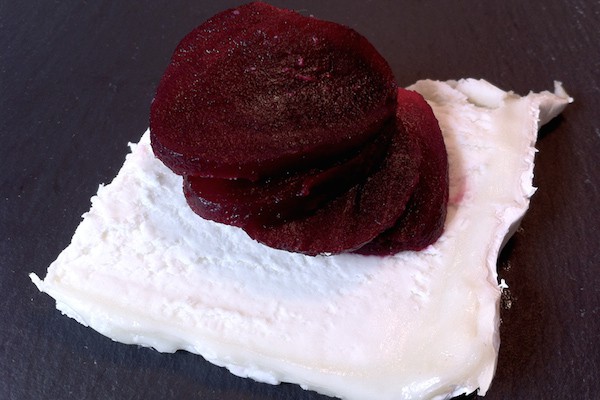
Coach Farm is searching for a name for its new raw aged goat’s milk cheese. Several bloggers received samples of the cheese so they could taste and describe it for our readers. Today’s post comes from Matt Spiegler of Cheesenotes.
The black and red logo of Coach Farm probably looks familiar to you; since Miles and Lillian Cahn started Coach in 1985, they have grown the farm into one of the signature goat cheese brands on the market. The Cahn’s are actually the original family behind the Coach handbag brand and that’s where they first made their fortune, before deciding to “retire” upstate a couple hours north of Manhattan, near Pine Plains, NY, with big plans of a relaxing life restoring an abandoned farm to working order and starting a goat creamery to create French-style cheeses for the New York City market.
Needless to say, the “relaxing” part of the plan never quite happened; they soon realized just how much time, work and dedication it would take to get the farm up and running and the cheese moving. Rather than give up, they sold Coach Leatherware (ironically, to the Sara Lee Corporation, so a large food company was expanding into leather goods even as they were moving into food production) and moved to the farm full time.
The story has a happy ending, as evidenced by the ubiquity of Coach in cheese cases (mostly on the East Coast but expanding healthily) and their frequent successes at the American Cheese Society competitions. Despite the challenges, they have now expanded to a 1000+ herd and are producing a variety of fresh, aged and flavored pasteurized goat’s milk cheeses. If you want to learn more about their journey from high-fashion bags to wheels of cheese, check out Miles’ book The Perils and Pleasures of Domesticating Goat Cheese for a behind-the-scenes, and often hilarious, look at the realities of goat farming and cheesemaking.
All of which brings us to the present day! Coach Farm is now working on their first aged cheese made with RAW goat’s milk cheese. After a lot of R&D and trial and error this beautiful cake of a wheel is finally getting close to being market-ready. But now they need a name!
Tasting: Raw Goat Cheese
The wheel is large, around 8 inches in diameter and 4 inches in height. The Rind is firm and thin, an even blanket of snowy white mold over a pinkish-brown underlayer. There is a thick ivory creamline just under the rind, the sign of proteolysis beginning to breakdown and liquify the paste, but oozing is minimal even as it warms, just a light bulging outwards and no liquid runniness, indicating a balanced aging. Beneath the creamline the paste is evenly developed, smooth, and crumbly with a beautiful fudgy texture, a little bit chalky.
The aroma of the cheese is bright, citric and milky, with a distinctly yogurt-y quality and hints of mushroom and mold. The flavor is well-balanced, excellent salt levels, tangy and creamy, with subtle mineral and floral notes, and a touch of gamey sharpness and bitterness at the creamline. This is a mild but complex cheese with a very clean finish; the best bite includes a bit of paste, creamline and rind. I tried the cheese with a few pairings as well; the first was with Kimchi (hat tip to cheese master Tia Keenan for introducing me to the kimchi/goat cheese concept); the fiery bite of the kimchi was tempered by the cheese while also bringing out fruity and sweet notes in the cheese. The second was a pickled beet, which was also lovely, although it’s hard to go wrong with the beet and goat cheese combo, they just pair very naturally. The third was with honey from the Brooklyn Honey CSA; while the components of the pairing were delicious on their own, the cheese was a little lost under the assertive, complex sweetness of the honey.
I have to say, I’m quite curious about the culture blend and the aging protocol that’s being used with this cheese: being a raw milk cheese, they are required to age it for at least 60 days, which would normally be a long time for a cheese of this style. The development of the creamline, the moisture levels and the intensity level of the flavors are closer to what I would expect from a younger cheese of this style. There’s clearly been a lot of tweaking and finessing with the make and affinage, to create a wheel that can age for that long a period without over-ripening, either in the direction of being overripe or hardness.
Personally, I like the idea of a name that pays tribute to the terroir of their farm: perhaps Hudson River Goat, or Taghkanic Bloom. So now, it’s your turn! Do you have any ideas for a name for this cheese? Get over to the Hello My Name Is page on the this site, and submit your naming ideas!
Matt Spiegler lives in Brooklyn, NY, making and aging cheeses in his “nano-creamery” (aka his apartment) near the banks of the Gowanus Canal; he blogs about cheesemaking, cheese tastings and all things cheese- and dairy-related at Cheese Notes. Matt just completed the cheesemaker certification program at the Vermont Institute of Artisan Cheese and is always on the lookout for opportunities to expand his cheesemaking experience. He’s also a web designer when he’s not flipping wheels or sniffing rinds. You can find Cheese Notes on Facebook, Twitter, Instagram, and Pinterest.





